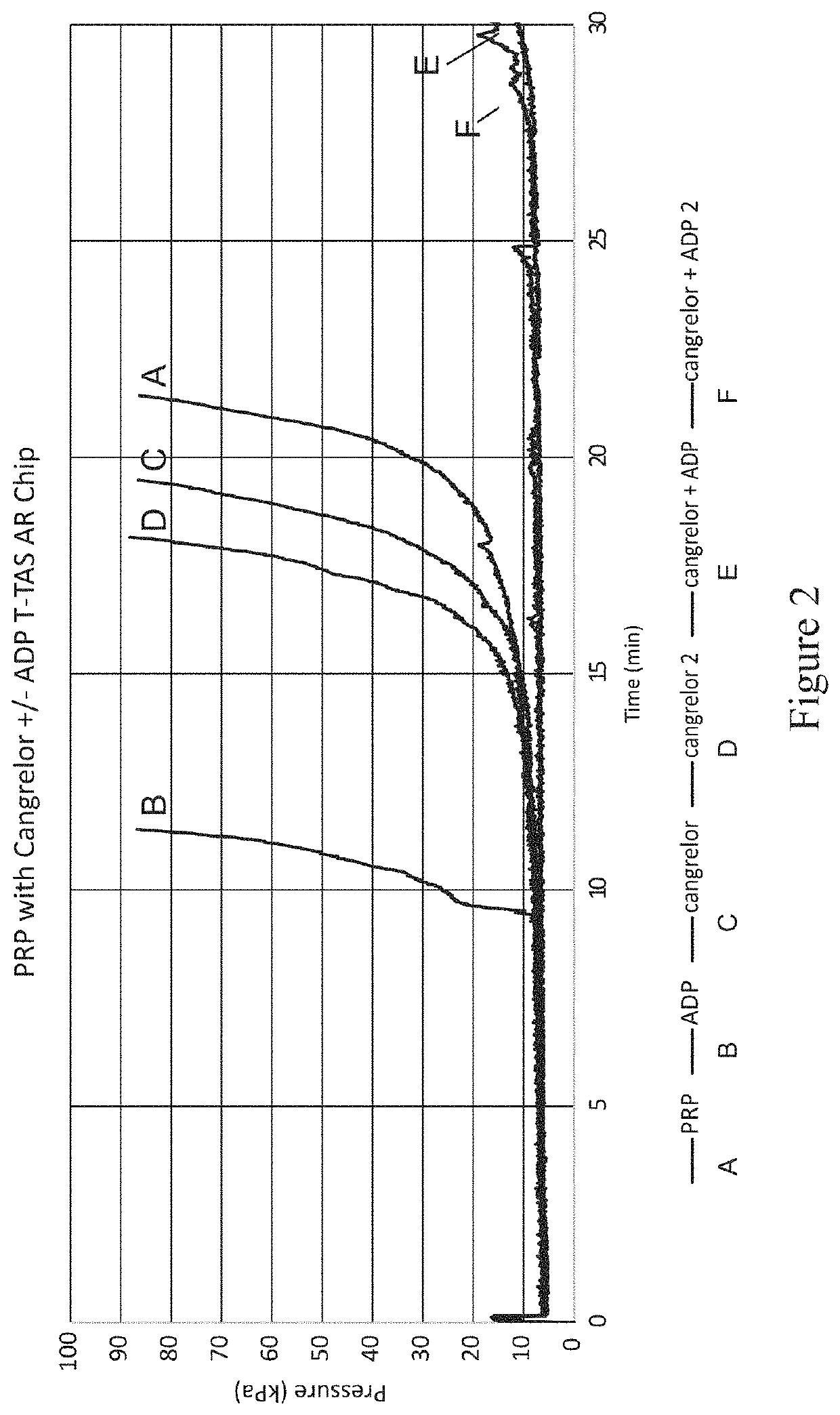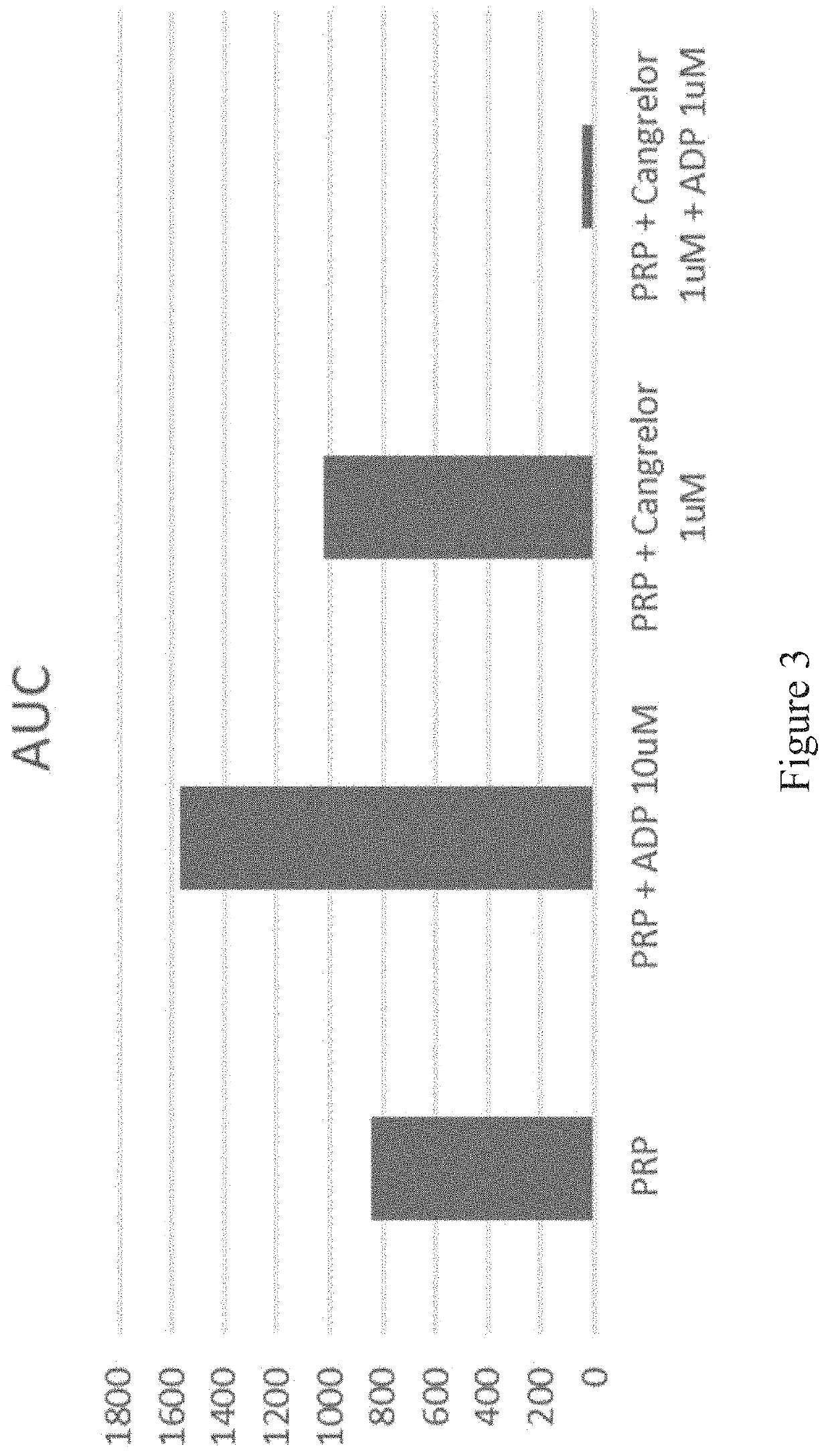Thrombosomes as an antiplatelet agent reversal agent
a technology of thrombosomes and antiplatelet agents, applied in the field of thrombosomes, can solve the problems of increased bleeding potential, increased risk of serious bleeding and related complications in the patient population, and additional complications, so as to achieve the effect of stopping continuing the treatment of antiplatelet agents
- Summary
- Abstract
- Description
- Claims
- Application Information
AI Technical Summary
Benefits of technology
Problems solved by technology
Method used
Image
Examples
example 1
P2Y12 Inhibitors
[0247]Cangrelor, like clopidogrel, ticagrelor, and prasugurel, blocks the P2Y12 (ADP) receptor on platelets. Cangrelor is used here as a representative of this class of drug.
[0248]Thrombosomes were prepared consistent with the procedure in Example 4. Transmission light aggregometry and T-TAS® experiments were carried out according to Example 4.
[0249]The effect of cangrelor on the aggregation of platelets in platelet-rich plasma (PRP; taken from humans as whole blood and processed to isolate platelets in plasma without white blood cells (WBC) or red blood cells (rbc) was evaluated by transmission light aggregrometry. Aggregation of platelets (platelet rich plasma) in response to agonist-induced activation showed complete inhibition of 10 μM adenosine diphosphate (ADP)-induced aggregation by cangrelor at therapeutic concentration of 0.5 μM-3.5 μM (FIG. 1). All doses of cangrelor investigated completely eliminated ADP-induced platelet aggregation in PRP.
[0250]The effect...
example 2
GPIIb-IIIa Inhibitors
[0257]The results that follow demonstrate the impact of thrombosomes in an in vitro model of a patient taking a GPIIb-IIIa inhibitor. Eptifibatide, a common antiplatelet drug, competitively inhibits the GPIIb-IIIa receptor on platelets which interact with fibrinogen and von Willebrand factor.
[0258]Eptifibatide is a peptide therapeutic that blocks the fibrin binding role of GPIIb-IIIa receptor on platelets. The drug is typically administered via IV as a 180 μg / kg bolus followed by 2 μg / kg / min continuous infusion. The blood concentration of eptifibatide is typically about 1-2 μM. Bleeding time generally returns to normal within about 1 hour of drug stoppage.
[0259]Thrombosomes were prepared consistent with the procedure in Example 4. Transmission light aggregometry and T-TAS® experiments were carried out according to Example 4.
[0260]The aggregation of platelets (in platelet rich plasma) was evaluated using transmission light aggregrometry. Eptifibatide completely i...
example 3
COX Inhibitors
[0265]The results that follow demonstrate the impact of thrombosomes in an in vitro model of a patient taking a COX inhibitor. Aspirin, a common antiplatelet drug, blocks the COX1 enzyme in platelets. COX1 is responsible for converting arachidonic acid to prostaglandin.
[0266]Aspirin is an irreversible cyclooxygenase (COX) inhibitor. The COX enzyme in platelets is responsible for synthesis of thromboxane A2, prostaglandin E2, and prostacyclin (PGI2). Aspirin permanently inactivates the COX enzyme within platelets, and since platelets do not have the nuclear material to synthesize new enzyme, new platelets must be produced to overcome the aspirin effect. Without thromboxane A2, prostaglandin E2 and prostacyclin (PGI2) platelets are limited in their pro-aggregation activity. Many people are maintained on a low dose of aspirin to prevent unwanted clotting events. Aspirin bioavailability largely varies with administration route, with a single 500 mg dose IV at peaks of 500 ...
PUM
| Property | Measurement | Unit |
|---|---|---|
| concentrations | aaaaa | aaaaa |
| concentrations | aaaaa | aaaaa |
| temperatures | aaaaa | aaaaa |
Abstract
Description
Claims
Application Information
 Login to View More
Login to View More - R&D
- Intellectual Property
- Life Sciences
- Materials
- Tech Scout
- Unparalleled Data Quality
- Higher Quality Content
- 60% Fewer Hallucinations
Browse by: Latest US Patents, China's latest patents, Technical Efficacy Thesaurus, Application Domain, Technology Topic, Popular Technical Reports.
© 2025 PatSnap. All rights reserved.Legal|Privacy policy|Modern Slavery Act Transparency Statement|Sitemap|About US| Contact US: help@patsnap.com



